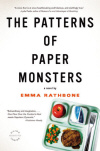The Patterns of Paper Monsters
Emma Rathbone’s debut novel The Patterns of Paper Monsters is about Jacob Higgins, an angry kid incarcerated in a juvenile detention center. But like any great book, this one can’t be reduced to its plot. Its magic lies in the sarcasm that drools from its narrator’s voice and in the beauty of the way that voice strings together language. Listen, as Jacob describes the crime that landed him in the JDC:
Emma Rathbone’s debut novel The Patterns of Paper Monsters is about Jacob Higgins, an angry kid incarcerated in a juvenile detention center. But like any great book, this one can’t be reduced to its plot. Its magic lies in the sarcasm that drools from its narrator’s voice and in the beauty of the way that voice strings together language. Listen, as Jacob describes the crime that landed him in the JDC:
As for me, what I did was simple enough. Nothing quirky or diabolical. I didn’t do anything sweeping like corral a bunch of single moms into a boardroom and then gas it. I didn’t realign the universe so all the planets crashed into one another and the stars got swept up like a tablecloth and all the skin got sucked off our faces. I didn’t make everyone watch while I transported a graceful, mythical beast from back in time, and then set it on fire.
What I’m guilty of is a pretty standard, run-of-the-mill armed robbery. More American than grass stains and painted curbs, with a little brutality thrown in for good measure.
Oh, and did I mention the humor? It is how Jacob Higgins copes. Humor is how he survives the motley crew of self-absorbed social workers and guards who put him through the motions of rehabilitation. It is how he survives the institution food, which he says “feels hostile.” It is how he survives the “minty, sterile kind of cold […] that is always just short of freezing [his] balls off.” His humor, constructed out of the subtle and dark ways he manipulates language, keeps both him and us entertained, chuckling as we turn pages.
Rathbone’s attention to minutiae also makes Jacob’s world utterly real and sensate. She, or rather Jacob, describes the inane process of checking out pencils, of signing honor slips in order to use antiquated computers that have seizures and reboot if you type too fast, of being herded into a rec room to eat waxy cookies that could only be appreciated by “an astronaut who had lost touch with home base and [had] run out of things to eat.” Jacob notices staples “embedded in the blue carpet.” He notices that the smoke detector in the rec room beeps every five minutes because no one has thought to change its battery. And he painstakingly describes the strawberry icing on wafer cookies, almost his singular pleasure.
Rathbone’s characterization, seen through Jacob’s eyes, is also pitch perfect. Of another inmate, Jacob says, “His face was so raw with his lips curling and his insides spilling out that there was something genital about it.” He says that his mother’s boyfriend “has the anger and sense of entitlement of a Vietnam vet except without the traumatic combat experience to explain it.” He describes his mentor Jim as “someone you would see trying to straighten out a picnic blanket.” But it is Andrea, a girl he likes, who he captures best. Early in their interactions, he says, “It was like she was the underside of a leaf, smarting and naked and veiny.” Later, he says this:
Sometimes she’ll make a little animal gesture, like turn her head really quick to look at something, and I’ll feel like I recognize her from an ancient time. Some of her teeth are whiter than her other teeth. Once, in the computer room, I saw her smell the eraser at the end of her pencil after she’d used it […] It’s like I think about her all the time. Like every moment has a little pupil of Andrea. I knocked my toothbrush off my sink the other day and the sound it made when it clattered to the floor reminded me of her.
It is at moments like these that Jacob’s voice transforms from biting sarcasm into raw earnestness. But Rathbone is careful not to let Jacob’s voice turn sappy. She retains the “likes” that characterize the imprecise language of adolescents, and she captures the height of the emotion in a vivid sensory moment without explaining it away. It is at these moments that Rathbone knocks out your breath. It is for these moments that this book is worth every page.
My one disappointment, though, was in the book’s ending. After two hundred pages artfully navigated with a teenaged voice, two hundred pages in which Rathbone avoids the easy morals that sometimes characterize fiction written about young adults—a genre that sometimes condescends to its readers thus turning the “young adult” label into a pejorative term— Rathbone perhaps writes toward an expected sort of redemption. She does salvage herself a bit with the last line, which proves that the messiness of the brain space of a “possibly bipolar juvenile […] with only the most tenuous impulse of civility” cannot be easily tidied up. To Rathbone’s credit, I had high expectations for the ending given the exceptional quality of the rest of the book. And the book’s ending certainly did not cancel out the novel’s numerous strengths. I would undoubtedly read it again.
It is exactly the type of book you could thrust into the hands of a ninth grader to make him love reading. It is also the type of book you could slide across the desk of a creative writing student to show her how to nail voice, detail, humor, and prose. It is a book you’d read out loud to a parent who’d forgotten the joys of reading. And it is one that could reconfigure the entire juvenile detention system because this book perfectly occupies the headspace of a kid trapped in an institution that doesn’t remember what it was like to be young.





